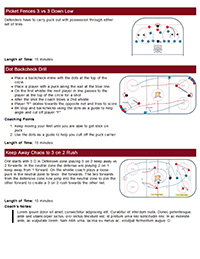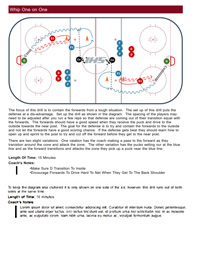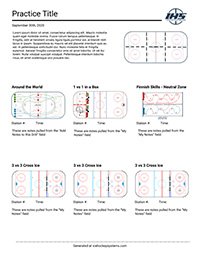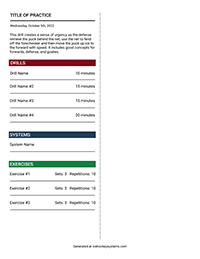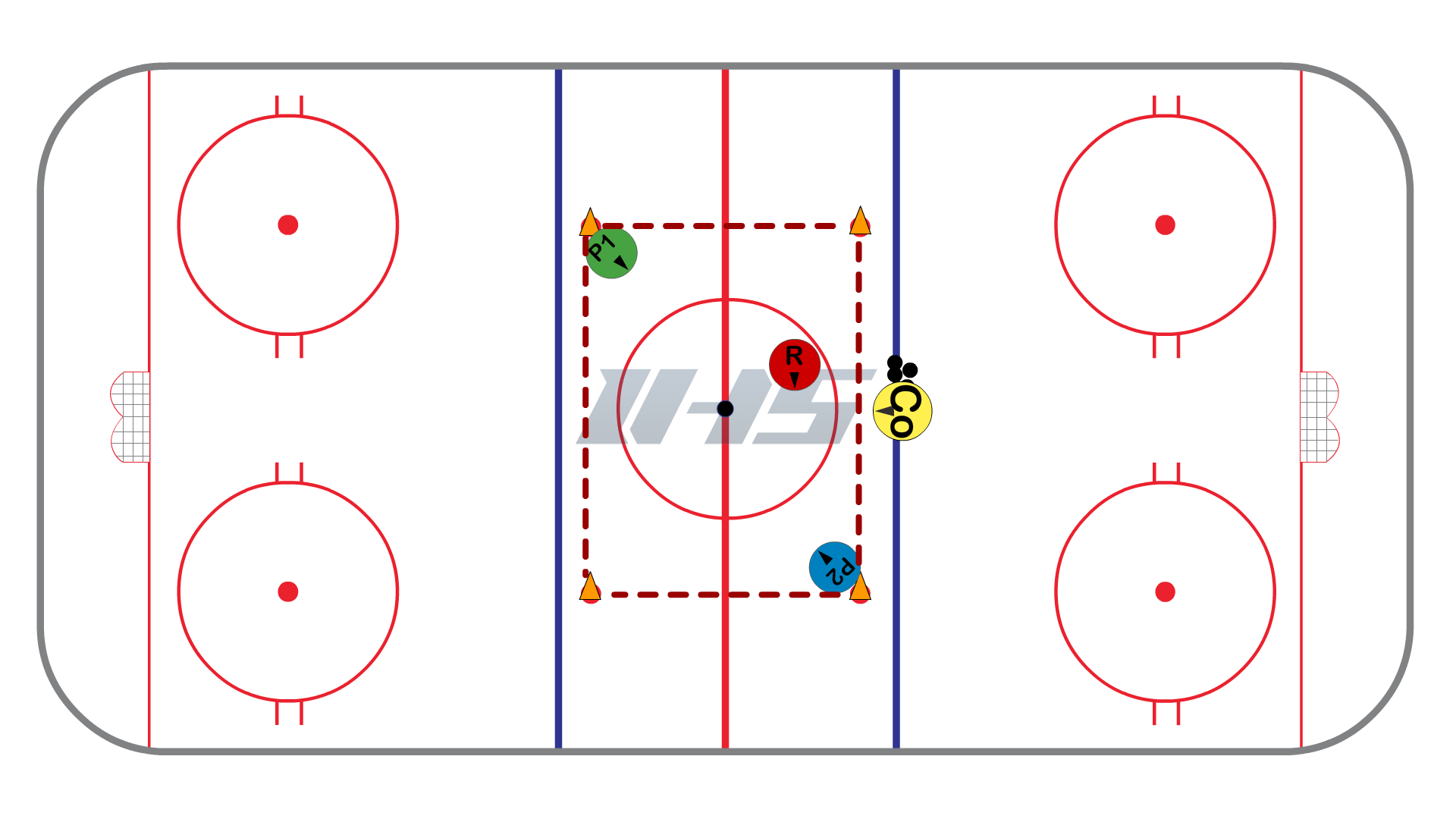
U10 - Passing, Puck & Player Movement
U10 - Passing, Puck & Player Movement

Practice Notes
This practice develops passing skills, including the ability to make and receive a variety of passes, reading open spacing, and how to get open to be a passing option when players don't have the puck.
Encourage players to think about where they are passing to, the weight of their passes, and how they can utilize the boards and/or open space to make indirect or area passes. For players off the puck, encourage them to think about how they can be a better passing option or how their movements could open up space for the puck carrier.
Head Up Scan The Ice Warm-Up
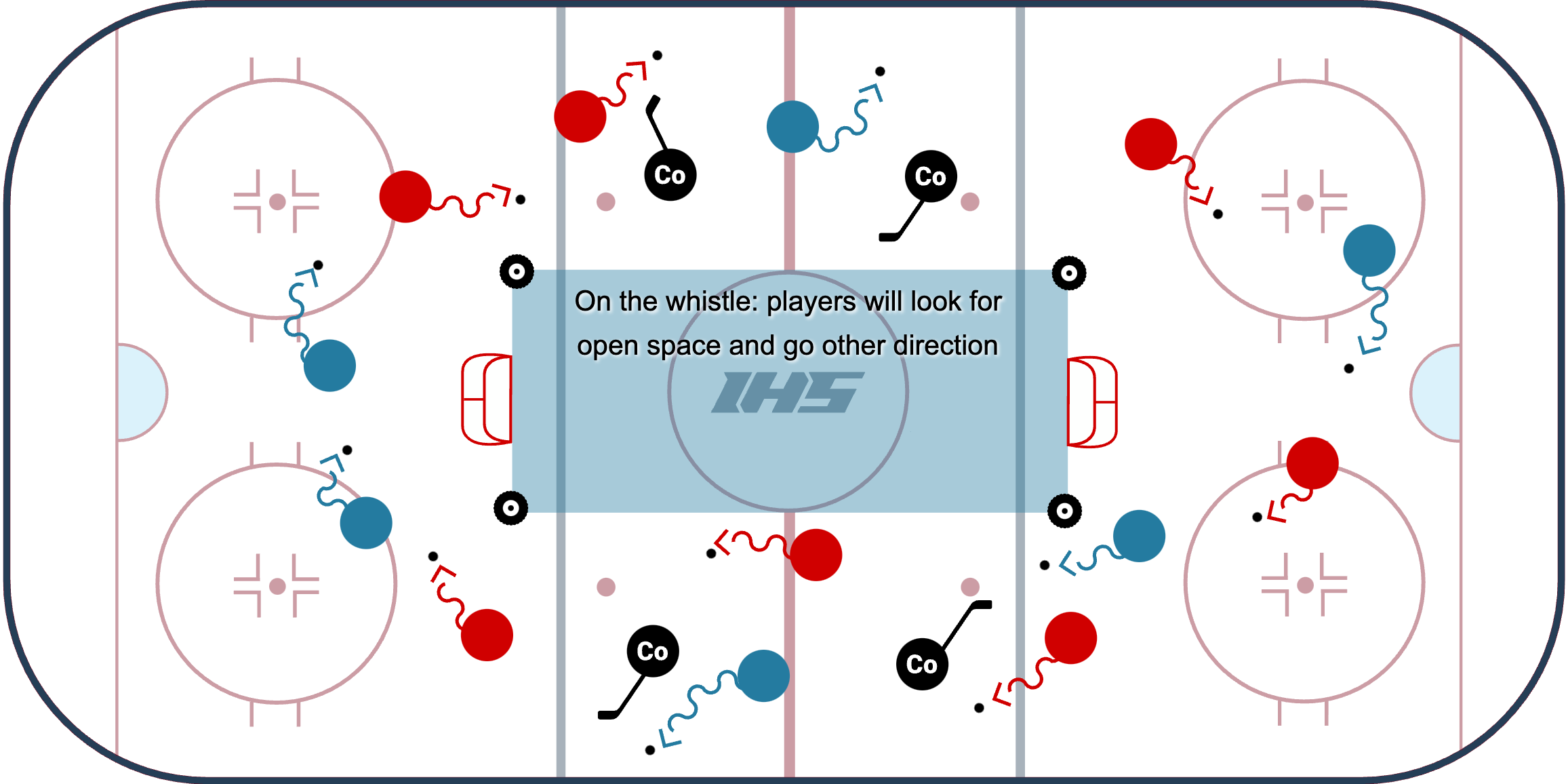
The Head-Up Scan The Ice Warm-Up from Dwayne Blais of the NSDA is a simple yet highly effective warm-up drill that is great for all age levels. The goal of this warm-up activity is to get players in the habit of keeping their head up while they stickhandle so they can look for open ice and evade obstacles.
Setup
- Can be set up to be full-ice (like it is shown in the video) or half-ice.
- On the whistle, all players skate in the same direction.
- On the next whistle, players check their shoulders and turn to go in the opposite direction.
- Coaches can add obstacles (cones, sticks, tires) that players must stickhandle around, and coaches can also be obstacles (like shown in the video).
Coaching Points
- Players should practice keeping their head up!
- Players must shoulder check and look over their shoulder to determine where the open ice is.
- Coaches should encourage players to keep their head up as much as possible during practice. Players can't keep their head up in the game if they do not learn the skill at practice!
Variations
- Can be full ice, half ice, or in zone setup.
- The coach can blow the whistle to change directions every 10 - 20 seconds for younger age groups or every 3 - 5 seconds for higher-skilled groups.
- Can add obstacles and / or defenders that players need to be aware of and stickhandle around.
3 Player Figure 8 Passing
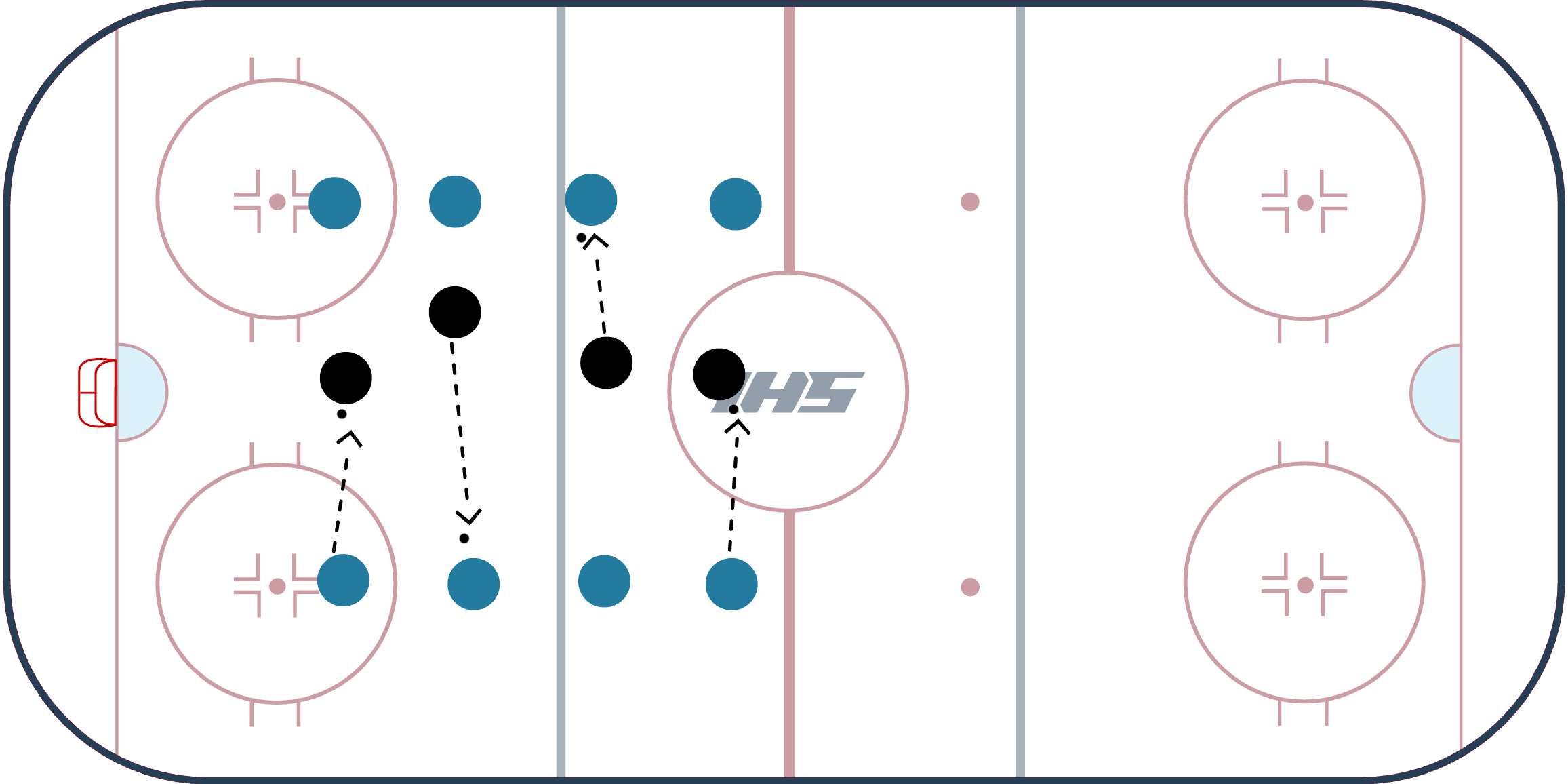
The 3 Person Figure 8 Passing Drill from The Battery Hockey Academy is a simple passing exercise that is great for practicing one touch passing and important habits like keeping your stick on the ice and your head up. This drill can also be modified so a variety of skills can be practiced.
Setup:
- This can be set up as a small station, or a half-ice or full ice activity. The further the players are away from each other the more challenging it is because it requires longer passing and more skating.
- 3 Players are set up anywhere in the ice. The center player passes to the outside player and skates around them before passing to the 3rd player. After 15-30 seconds, or a set number of passes, players rotate.
Coaching Points:
- Head up!
- Communicate verbally and non-verbally (put your stick on the ice where you would like to receive the pass).
- Hands away from the body so you can easily push with bottom hand and pull back with the top hand.
Variations:
- Passing: practice one-touch passes, normal forehand passing, backhand receiving (have stationary passers pass to the backhand), saucer passes.
- Skating: can skate forward or skate backward.
- Obstacles: can add objects or cones that players must skate, pass or protect the puck around.
Ensure each player gets 2-3 reps in each position. Challenge players to work on various kinds of passes (one-touch, forehand, backhand, etc). The goal is for players to keep their feet moving, give good targets, and move the puck quickly and efficiently.
Give & Go Rover
This game emphasizes using give and gos in a small area. Players will have to learn the concept of passing and moving to space in order to be successful. To set up the drill create a square area using cones. The size of the box can depend on the age and skill level of the players.
Two players will play against each other and 1 player will be the "rover". To start the drill place a puck in the middle and have the two players compete to gain possession. When a player gains possession they try to make a pass with the "rover" and then skate to open space to receive a pass back. When they do this they earn a point. If the puck goes outside the boundary the coach plays a new puck into space.
Coaching Points
- Players need to protect the puck and expose it when ready to make a play.
- Place an emphasis on passing and moving.
- No players should even be standing still.
Split your players up into two groups. Half the group will start with "Give & Go Rover" and half will play "3v1 Keep Away Game". After 6-8min, switch groups.
3 vs. 1 Keep Away Game
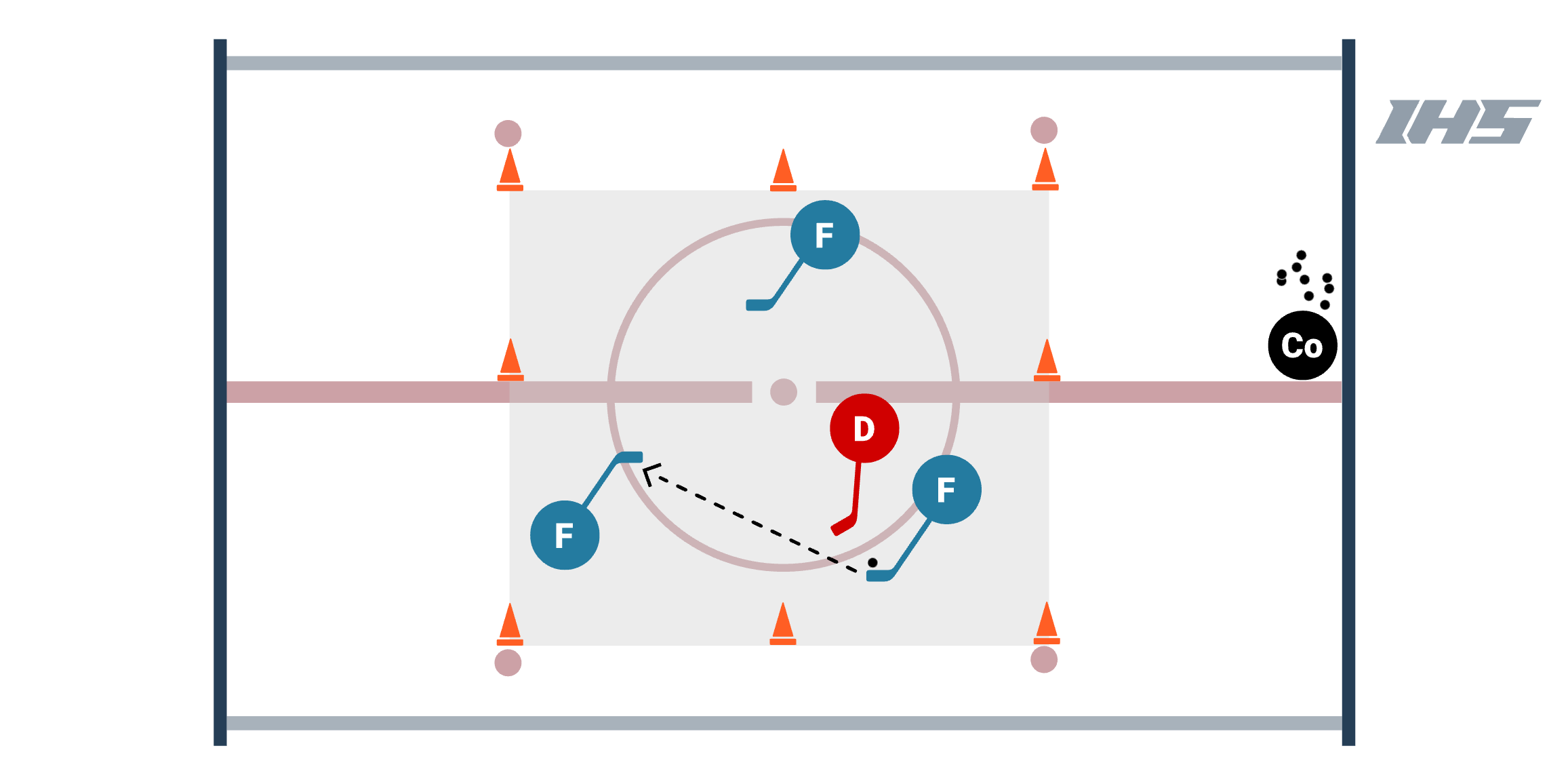
The 3 vs. 1 Keep Away Game is as simple as it sounds but the fundamentals and habits players learn while playing this game are extremely valuable.
Keeping your head up, stick on the ice, moving to open space and communicating with your teammates will lead to success.
Game Rules
- 3 players work to keep the puck from 1 defender.
- Defense gets a point for stripping the puck and skating it out of the playing area, or if the puck goes out of play.
- Offense gets a point if they can keep possession of the puck until the coach blows the whistle.
Offensive Coaching Points:
- Head up!
- Stick on the ice to give your teammate a target.
- Poise when you have the puck. This takes practice! It is ok if you try new moves and make mistakes.
- Move to open space without the puck.
- Communicate verbally and non-verbally with your teammates.
- If you have the puck, use deception or false information (fake passes, no looks, skates & hips pointed opposite direction, etc) to get the defender to commit or open up.
Defensive Coaching Points:
- Stick on the ice at all times (so you can block passing lanes, pick off passes or angle players to go in a certain way).
- You are at a disadvantage in this game. Be smart about your movements. Do not chase and swing stick out of control.
Variations:
- Can be 2 v 1, 3 v 1, 3 v 2, 4 v 1, 4 v 2 or you can make it more challenging for the offense by going 2 v 3, 2 v 4.
- Can make the playing size smaller or larger.
- Can require forwards to get a certain number of passes to end game or keep possession of the puck for a certain amount of time to win the game. Time can be anywhere from 15 - 45 seconds. Can also keep track of how many passes are made during 30 seconds.
- If you have a goalie, require the forwards to make 3, 4 or 5 passes before they can shoot on net. If the defense strips the puck, allow them to take a shot on net. The goalie can work on tracking the puck during the passes.
2 vs 2 Rebound Battle Drill
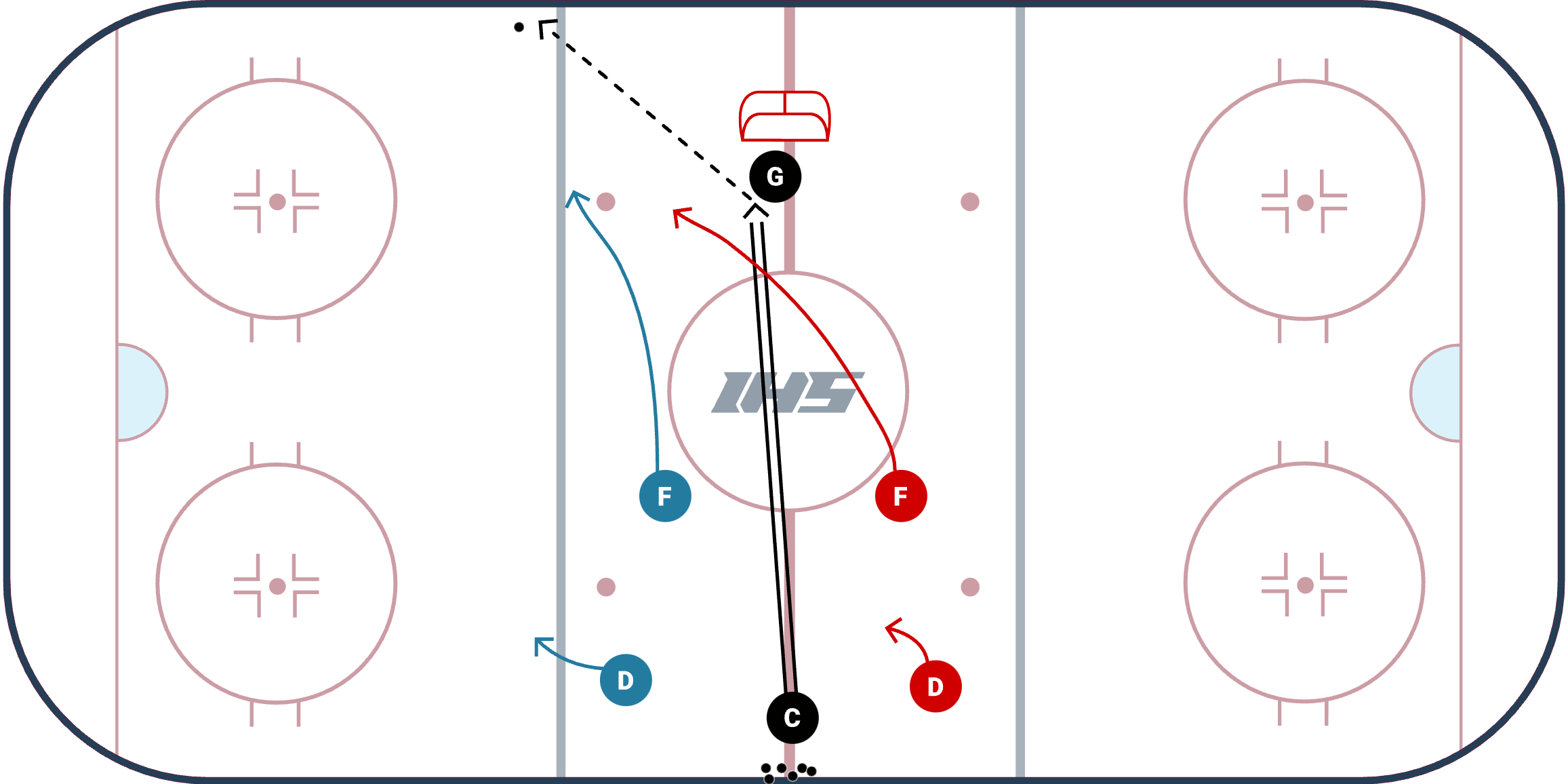
Winning loose puck battles is a major deciding factor in the outcome of a game. This battle drill challenges players to compete for a loose puck after a rebound and have the awareness to pass the puck to their teammate at the point. After the loose puck battle is won, the player passes it back to their teammate at the point, which will begin a 2 vs 1.
Setup:
- This can be setup to be a station, or a half ice drill.
- A coach or player dumps the puck on net and the goalie plays it to either corner.
- 2 players are spread out and charge into the corner to compete for the puck. Whoever comes out with the puck must pass it to their point player to begin a 2 vs 1.
- The drill is stopped after a goal, the goalie freezes it, or the puck is moved out of the zone.
Offensive Coaching Points:
- Players who arrive at the puck first should work on deceptive fakes with their body to escape from the corner. Fakes with your hips and pointing your skates in the opposite direction are extremely effective in this situation.
- Once you have the puck, protect it, get your head up and make a pass to the point.
- The point should be active calling for the puck and moving to space.
Defending Coaching Points:
- The defender should work on playing the body in the corner with stick on puck.
- When 2 vs. 1 begins, the defender should hold the middle and try to force a bad angle shot.
- Have good stick position. Do not swing your stick as it will open up passing lanes and make you off balance.
Variations:
- You can allow the point player that does not receive the pass to jump into the play so it is a full 2 vs 2.
- You can have only one point player, which is demonstrated in the 2 vs 1 Rebound Battle.
Progress to "Add A Man" version: If a player in the game makes a successful pass to the next teammate in their line AND that player makes a successful pass back to either of the players in the game, they can activate to make it a 3v2.
Double Goals Game
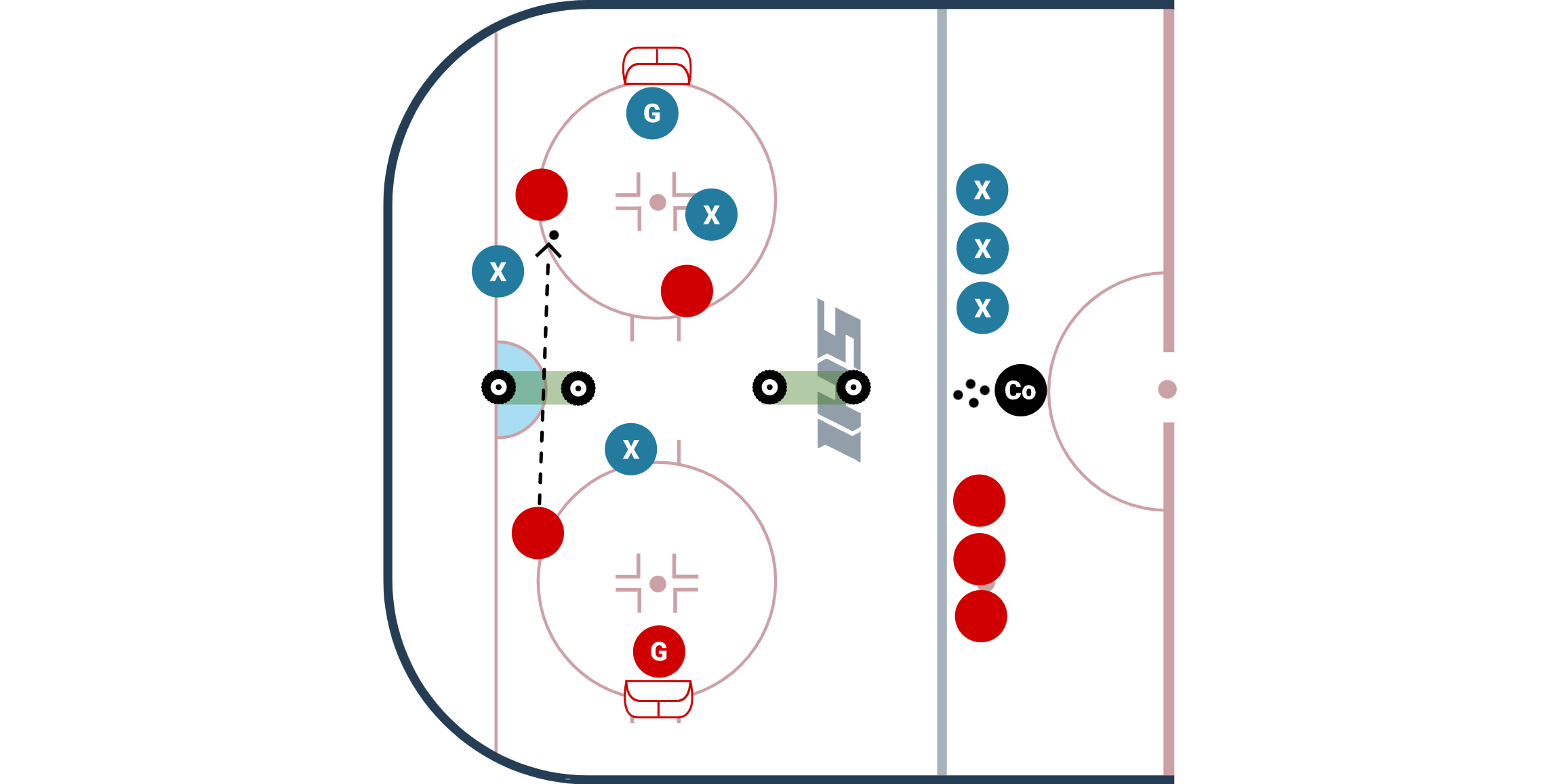
Double Goals Game is a fun and competitive 3 vs. 3 small area game that allows players to score goals by passing through the gates, or scoring on a goalie.
A pass through the gate counts as 1 point (players can't pass through the same gate twice in a row) and a goal on the goalie counts as 3 points. The two options to score goals forces players to be creative and pick their heads up to be aware of their surroundings. Below we will list the setup, coaching points, and additional variations.
Setup
- Set up two nets in a zone (as pictured in the diagram).
- Set up two "gates" in the middle of the ice (as pictured in the diagram) with cones or tires.
- Split up the teams and play 3 vs. 3 with 2 goalies. The game can be modified to be 2v2, 3v3, or 4v4.
- Keep score!! Teams can score 1 point if they pass through a gate (players can't pass through the same gate twice in a row). Goals on a goalie count as 3 points.
Coaching Points
- Keep Your Head Up: This game is all about awareness. The offense needs to look to score in different ways and the defense needs to be aware of the gates in the middle of the ice.
- Communicate With Your Teammates: This is a fast-paced game and important for teammates to communicate with each other.
- Jump To Space: Offensive players need to work on jumping to open ice to be an option for their teammates.
- Keep Stick On Ice: Defense can block passes and angle with their stick on the ice, while offensive players can give teammates a target to pass to.
- Cheer! Players at the blueline should cheer on their teammates and help keep score.
Variations
- Game can be setup to be 2v2, 3v3, 4v4 for cross-ice. Can also set up gates in the neutral zone for a full ice 5v5 game.
- Can require players to pass through a gate before they are allowed to shoot on net.
- Can also allow players to skate through a gate as a point.
- Can give different values for the goals (passing through a gate, skating through a gate, and scoring a goal are all ways to score points).
- Can make the gates larger for beginner players and smaller for higher skilled players.
- Can set the gates up in the Royal Road to encourage one time shooting for 2 point plays. View video of Double Gates - Royal Road.
